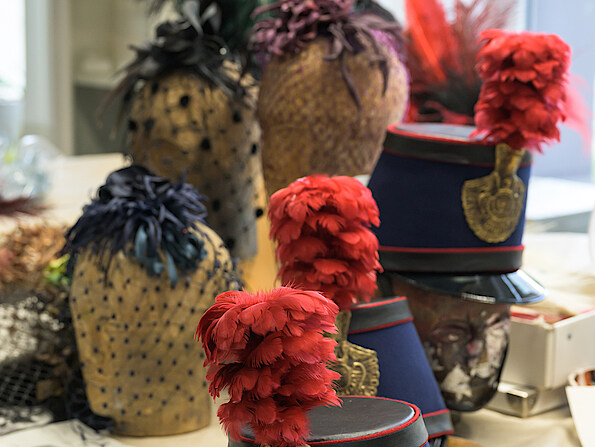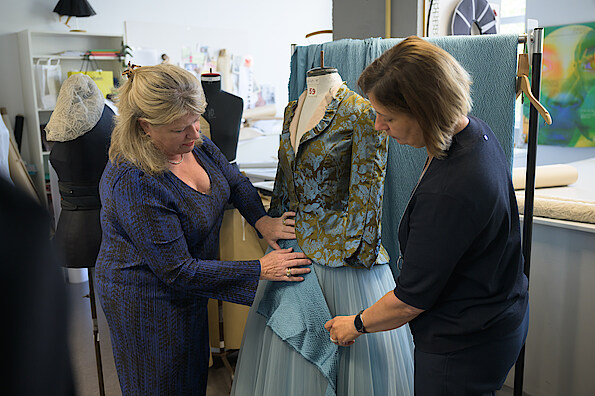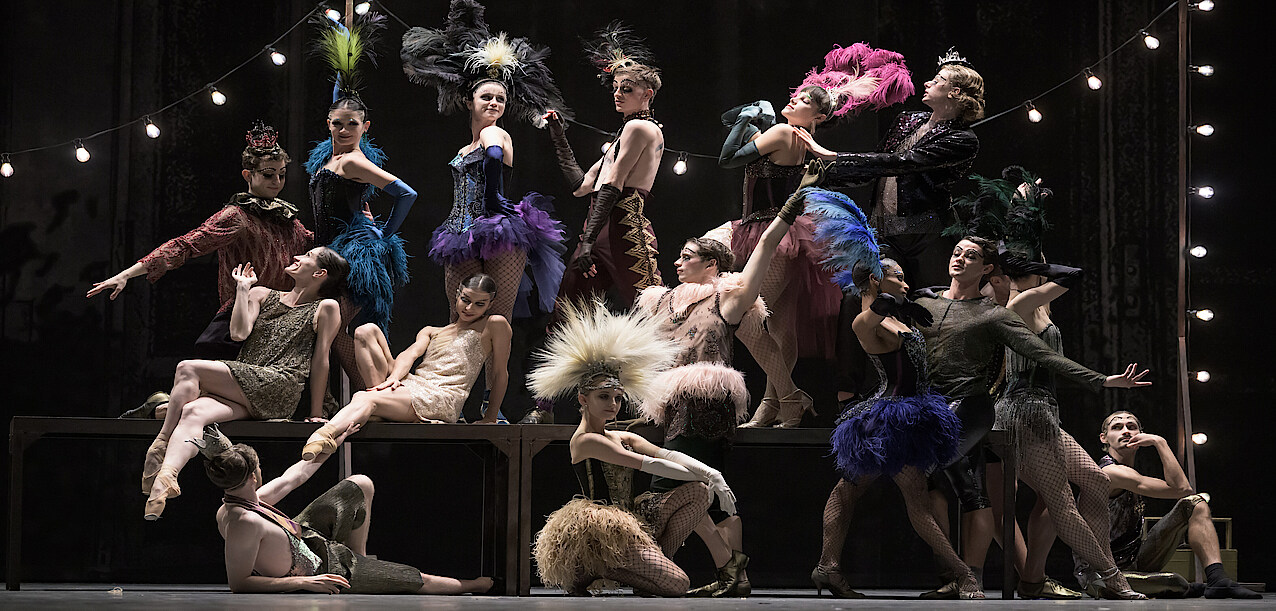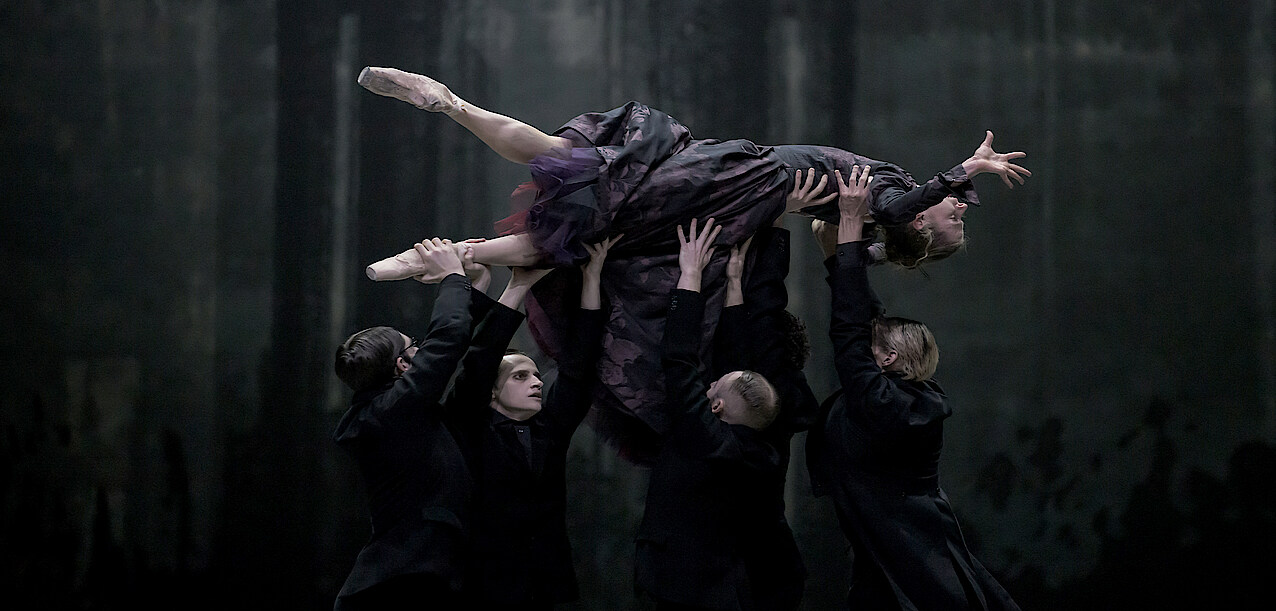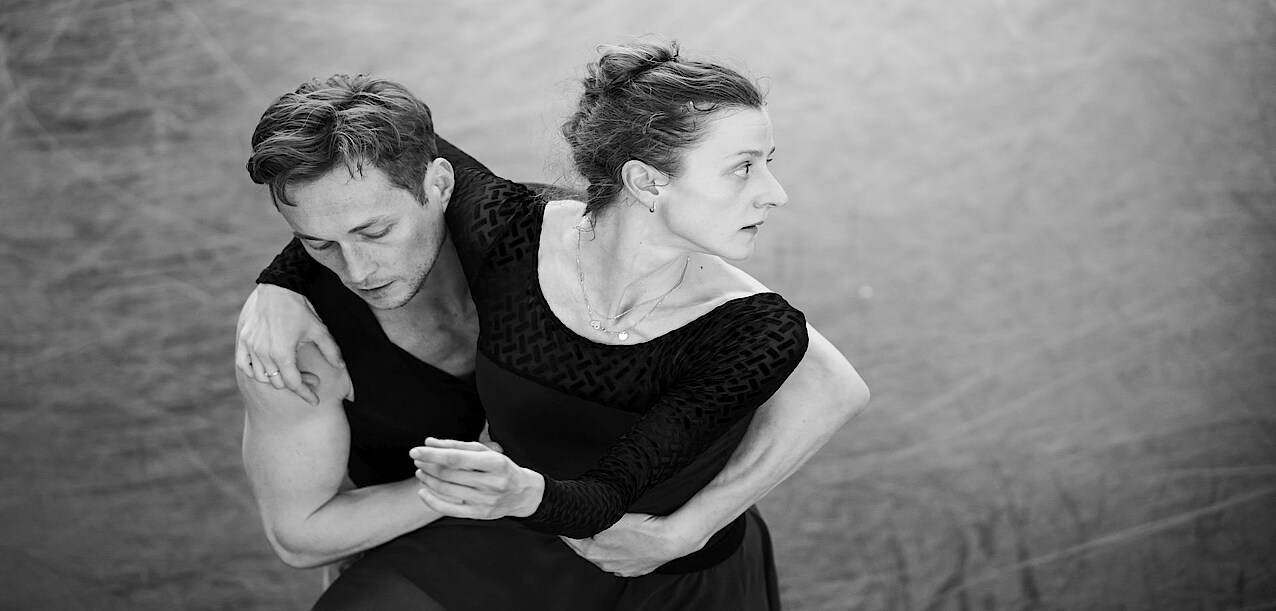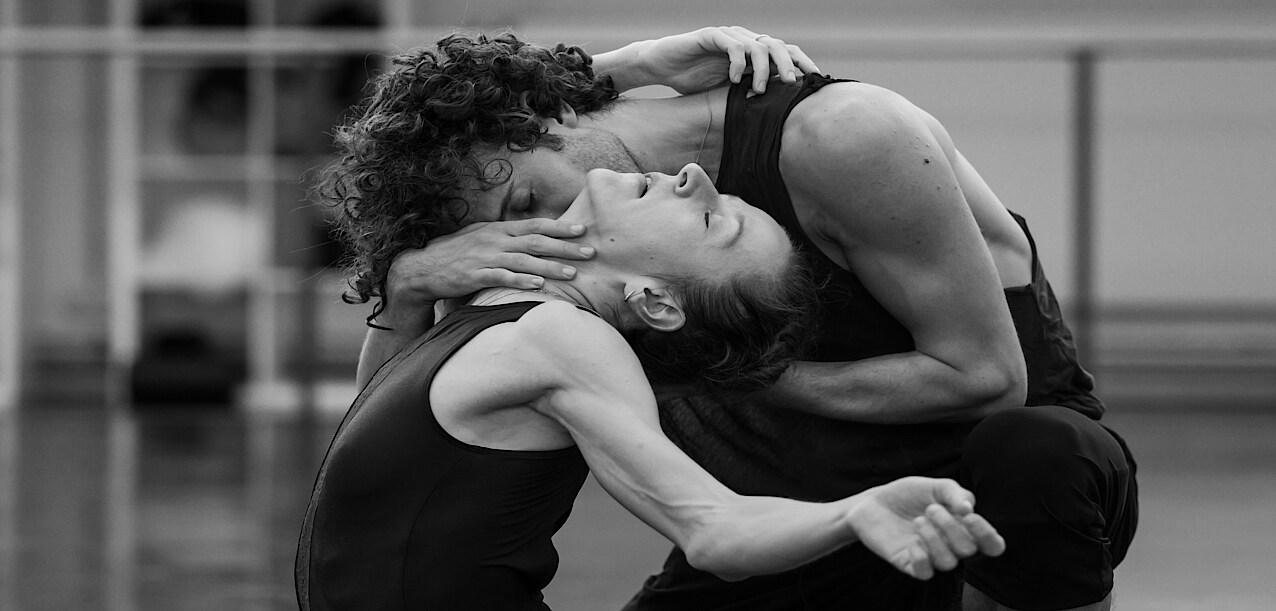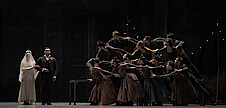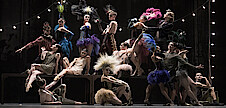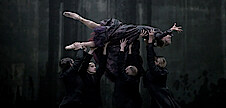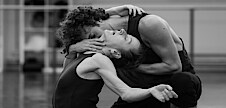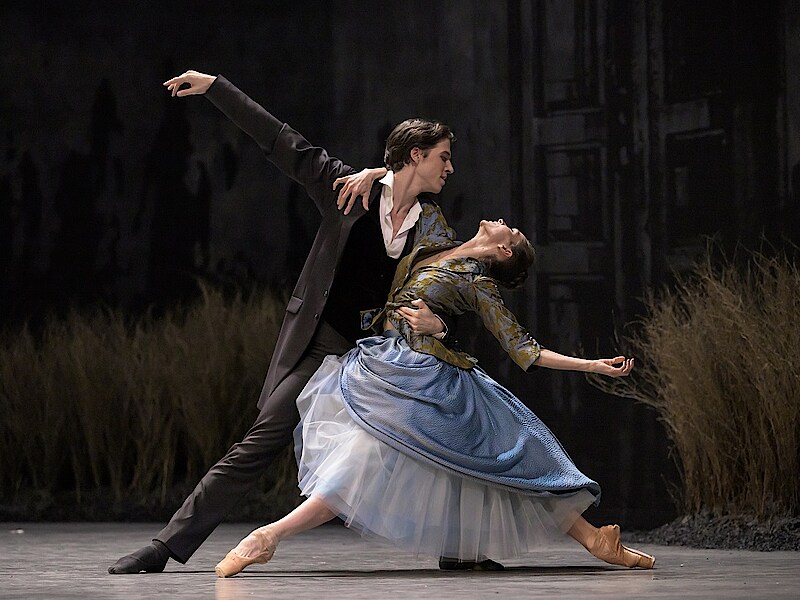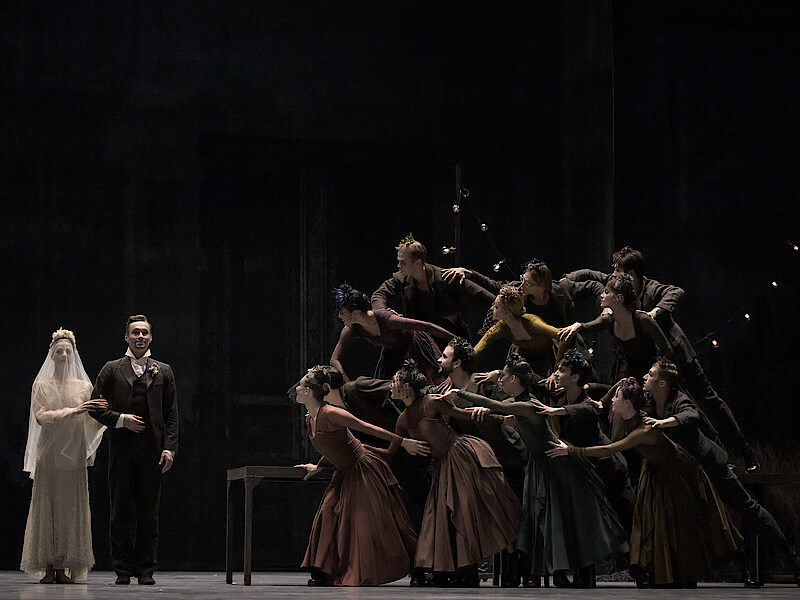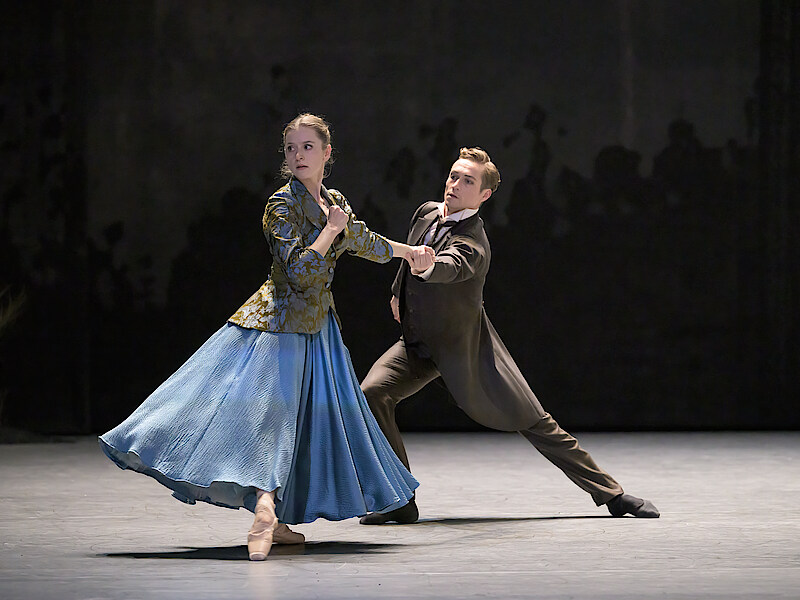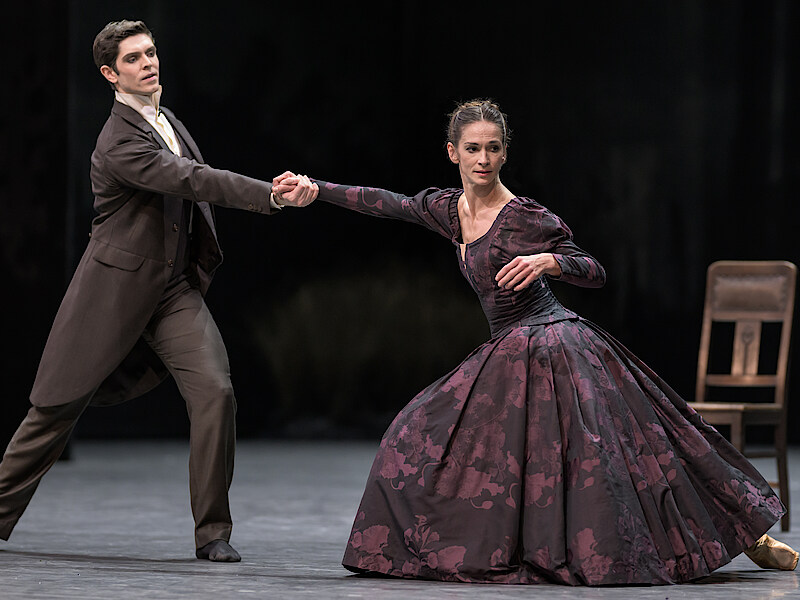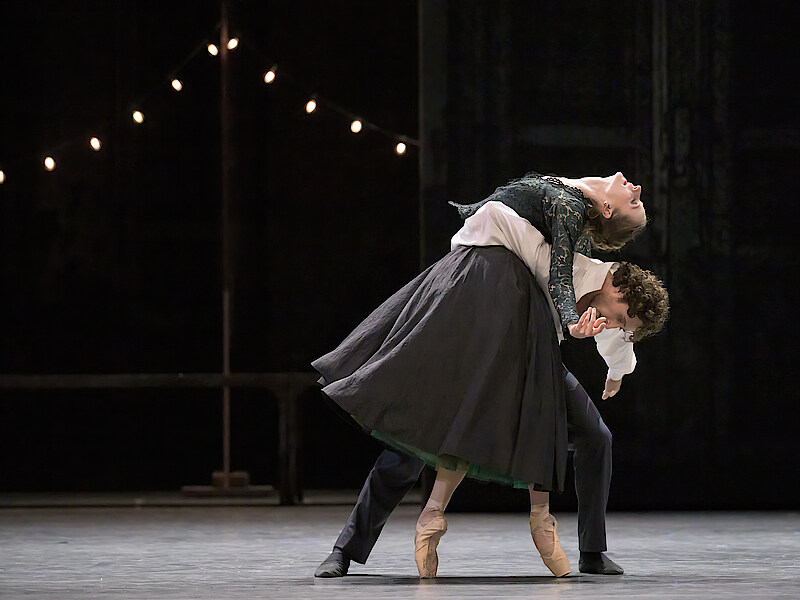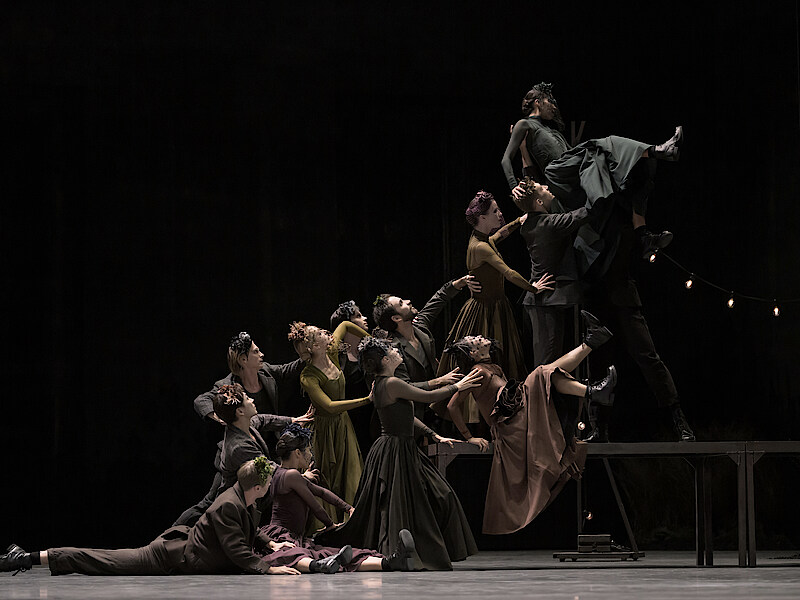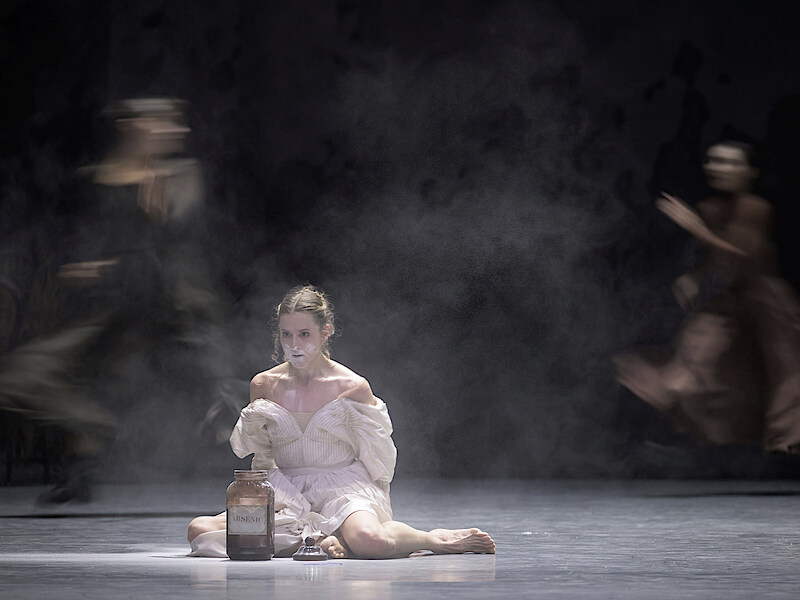
No further performances this season.
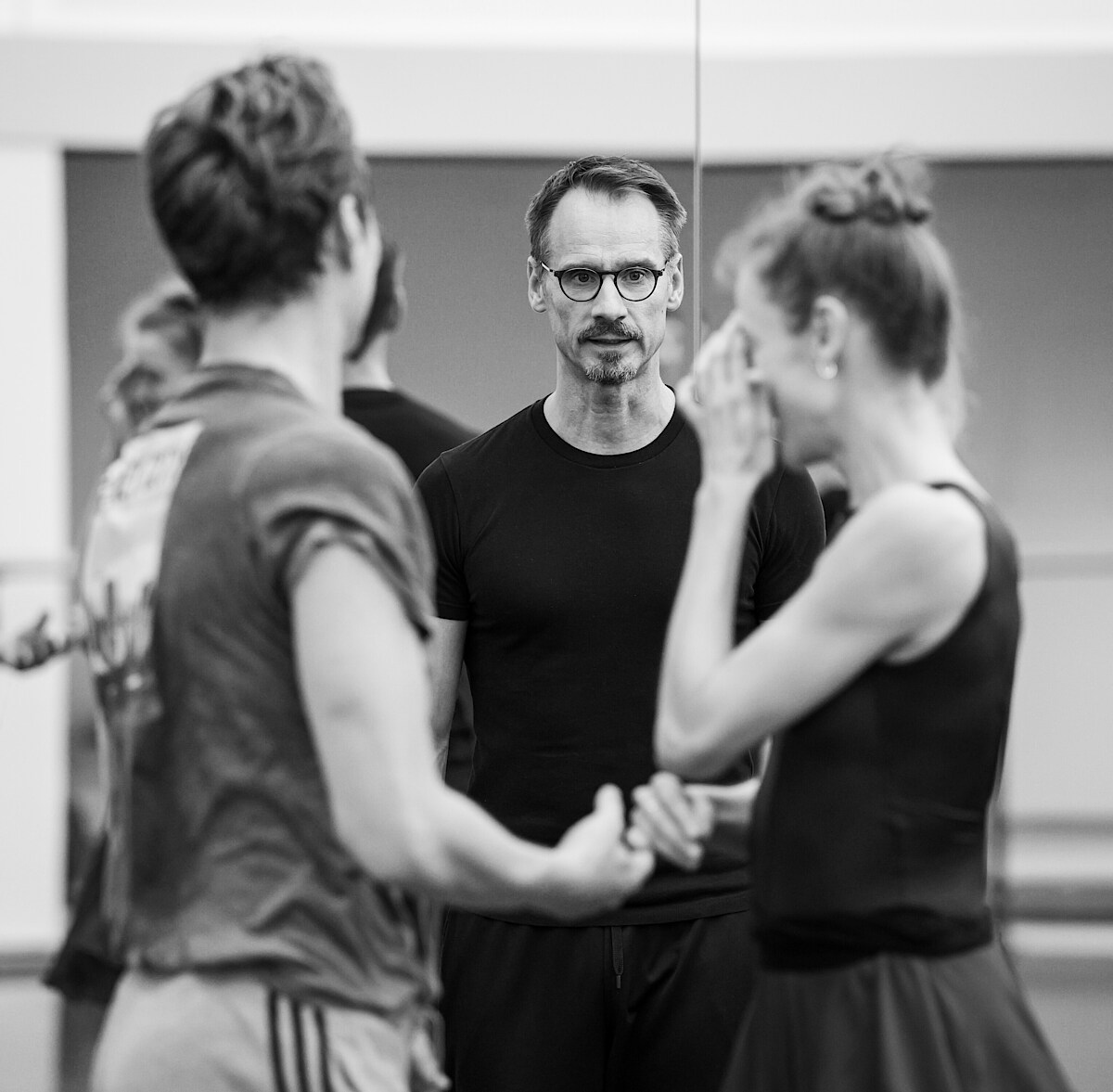
«You can't fill life with an illusion»
Trapped between desire and reality – Artistic Director Christian Spuck on his creation Bovary
Trapped between desire and reality – Intendant Christian Spuck on his new creation Bovary, the first premiere of the 23/24 season.
Gustave Flaubert's Madame Bovary, published in 1856, is a classic of French literature of literary realism and caused a scandal after its publication. Flaubert was charged with immorality but won the case. The novel portrays the young Emma Bovary, who feels trapped in her marriage and within the narrow confines of provincial life. Her attempts to break free from societal norms and shape her life according to her own desires with lovers and material luxuries lead into a downward spiral of debt, shame, despair, and ultimately suicide. In Bovary, Christian Spuck illuminates the inner worlds of the character and her tragic quest for fulfilment, which makes her a timeless symbol of human longing.
Staatsballett Berlin (SBB) Madame Bovary is a classic of world literature. Why exactly this work for a ballet?
Christian Spuck (CS) Madame Bovary has been following me since my earliest youth. I read it again now because I'm always searching for literary material, and the novel captivated me once more. The themes addressed in it have much to do with us today. I find the novel very relevant and inspiring in its vivid and detailed language. I find it exciting when conflicts that we can relate to or identify with are told on stage. What particularly interests me about Flaubert is that the characters on stage resist any clarity. Emma Bovary is a sympathetic character to me, yet I cannot understand what she does, and sometimes find her almost unbearable. The same goes for the other main characters. But that's exactly what I find exciting, even though it's a challenge.
SBB However, Bovary is not staged as a conventional narrative ballet but breaks narrative structures. Can you describe your approach to the literary source?
CS We have the problem that we cannot use spoken words on stage in ballet. One attempt to find an answer to this is certainly the choice of music, but also the choreography. There will be scenes that retell the plot of Madame Bovary. There are many moments, especially in the pas de deux, that tell the story, making it comprehensible. However, I am more interested in relationships and connections between the characters, their disappointed expectations, and their longings. Emotions can also be told abstractly. That's where the music comes into play, intentionally contrasting. For me, it's a continuous search for a form that describes what a narrative ballet could be today.
SBB How did you choose the music for Bovary?
CS The musical pieces by Camille Saint-Saëns, Thierry Pécou, and György Ligeti reflect the fractures contained in the work and, in their arrangement, create a drop height and thus also moments of surprise, allowing one to trace the complex themes of the novel. When it comes to narrative ballets, I try to make the outer world and inner worlds of the characters audibly perceivable in the music. I really enjoy doing that, but it's always difficult. For Bovary, it made sense to choose a French composer with Camille Saint-Saëns, and I came across his piano concertos, which I hadn't encountered in ballet before. The music by Ligeti and Pécou contrasts the French romantic sound and particularly shows Emma's torn perception.
SBB You just mentioned that it's important for you to tell conflicts on stage. In Madame Bovary, Flaubert deals with a range of conflicts revolving around themes such as marriage, addiction, excess, fantasies, and self-deception. Which aspects of these themes are particularly interesting to you?
CS The escape from convention is always exciting. That's where the conflict begins. Basically, I believe that there must always be a conflict dealt with on stage, either a conflict between each other or a conflict with oneself. For example, when someone no longer feels like they belong, doesn't want to or can't. That's still the main theme of our society in all its facets. The desire to want to be different from what one is and to create these desired worlds through consumption is important to tell. This attempt to find the desired happiness in luxury and consumption, to dress up and put on a mask, eventually leads to hiding from oneself. Producing this hide-and-seek game and false images of oneself is still en vogue today. I feel like we're all busy showing a certain image of ourselves to the outside world, especially on social media. No one there shows themselves as they really are or what they really do.
SBB Emma is a very ambivalent character. How do you see her relationship with her husband Charles? The conflicts in their marriage are not necessarily representative of the 19th century but also valid for our present time?
CS In this marriage, two different expectations collide. Charles only has the expectation that he can practice his profession. He truly loves Emma and wants to make her happy. He believes in the marriage, but he's also blind. He doesn't see the problem at all, and he doesn't notice how he's being lied to by her. It's not that he looks away; he truly doesn't perceive it. That's why, at the end of the novel, he has a breakdown when he finds and reads her letters. Nevertheless, he's not simple or naive, as he's sometimes read and interpreted. He has found strong structures in which he can find happiness. That's a form of freedom that may seem limited, but it gives him support and security. I believe he's a happy person. Emma doesn't have that, and that's also due to the time she lives in, as she cannot pursue fulfilling tasks. She fills her vacuum with the novels she reads and loses herself in her romantic ideas. In her arises the desire to experience these ideas and she also measures herself by them. But that doesn't work, of course. You can't fill life with an illusion.
SBB Nowadays, our romantic ideas are also nourished by books and movies; in this regard, we may behave similarly to Emma Bovary ...
CS Flaubert is said to have said himself: «Madame Bovary, c'est moi!» Perhaps we all have illusions or have learned from books or movies how we want to live and also how we want to love. I also remember the first great love films I saw and thought: that's how love should be, and that's how I want to experience it. I believe that we already have an expectation before we even enter a relationship. This can lead to problems when we try to call up and reproduce this feeling that is suggested to us from films or books. Emma sees what she wants to see. She directs her first major projection of romantic ideas to Rodolphe, her first lover. She projects her first great love onto him and doesn't notice at all that he's actually exploiting her completely. However, having an idea of something also means deceiving oneself and presenting oneself differently than one really is. I also discover this in Emma's shopping spree. When these projections fade or don't work, then she sees reality, and it's uncomfortable. Emma escapes into these dream worlds and tries to fill them through consumption. Hence her tragic downfall when she finally takes poison out of desperation and helplessness. I find it interesting to address her entire behaviour and this unreflected panic of having to react immediately in Bovary.
Quoted from the Ballet Paper No. 1. The conversation was conducted by Katja Wiegand.
Are we not all a bit Emma?
Reading as passion by Tanja Schwan
«Bovary» – a Name Like a Signal. A name that speaks volumes and continues to resonate to this day. As an abbreviation, it has long become a winged word that still makes one take notice nearly 170 years after a dazzling figure named Emma Bovary stepped onto the literary stage.
To its creator Gustave Flaubert, the title Madame Bovary was a cipher for an aesthetic capable of subverting the practice of expectation-conforming realistic storytelling. Through the titular character, Flaubert explores literarily how effects of reality can be produced when a figure emerges from and onto paper to unfold its own life as «Madame Bovary». Emma literally feeds on the readings she consumes and devours. Like a container, she absorbs everything she reads, becoming a body of text and even a piece of literature herself. She lives what she reads and how she reads it: driven haphazardly, excessively, and consuming herself in desires. We hear her parrot romantic phrases, see her lost in pseudo-mystical gestures of devotion, inventing one spectacular escape from the daily grind after another and exhausting herself emotionally and financially.
A passionate reader, Madame Bovary only "lives" as long as she reads. Once all illusions are exhausted and all ambitions spent, she miserably perishes. While Emma's misreadings may seem to pre-programme her failure to fulfil unattainable desires during her lifetime, the irony of the story remains that it is precisely this escape from reality that will bestow a literary afterlife upon the frustrated country doctor's wife: Emma must die so that (she) can become «Bovary».
Even in the novel, Madame's extravagant and wasteful lifestyle finds a posthumous imitator in her husband, who had until then been conspicuous only for his yawning boredom. In honour of the deceased, Monsieur Bovary, in a final act, adopts her penchant for staging life and death as a romantic opera – no matter the cost. Testifying to this is a monument he erects in her honour. Unexpectedly, Charles, consistently misunderstood and repeatedly betrayed by Emma as uninspired, embodies her clichéd notion of a fairy tale prince, as she had always dreamt of him. Ultimately, the whole tragedy (and comedy) of a ≪match made in heaven≫ unfolds only after Emma's death. Her suicide marks the birth of bovarysm, named after her. The so-called distorted self- and world-perception has not only outlived its namesake but has also gained reality value beyond the realm of fiction. From discourse product to discourse producer – a posthumous fame that Flaubert could not have invented more ingeniously for his literary character. The impact history could not better authenticate the attributed «Madame Bovary, c’est moi!».
Without Flaubert's ground-breaking narrative techniques, the deliberately banal plot of "Madame Bovary" would have been as quickly told as forgotten: A bored provincial beauty escapes the suffocating confines of her marriage through daydreams and affairs. Through retail therapy, she tries to escape her monotonous daily life and accumulates mountains of debt, before ultimately choosing suicide as the only remaining way out. So much for a newspaper notice that is said to have served as the author's skeleton for his «book about nothing».
The fact that this nothing could captivate generations upon generations and still provoke updates owes itself not least to the "reading damage" of bovarysm. From the early (manuscript) readers of Flaubert, whose fan mail collects the correspondence from the years starting in 1852, the bovaryistic line of a mimetic reading of the novel in the manner of Emma is drawn. As much as the author sought to prevent excessive identification with his protagonist and to push back against any empathy in favour of an impersonal style, Emma's spiritual heirs nonetheless founded a never-ending line of reception.
Madame Bovary, a media novel avant la lettre, provides a blueprint for intermedial adaptations. While the book functions before Emma's eyes as a prosthetic extension of the body, extramedial representation forms – a «performance» of the opera Lucia di Lammermoor with narrative means or pre-filmic writing techniques such as parallel montages – replace the narration in the key scenes and add more drama.
If one were to recognize in Madame Bovary a living storage medium for the sum of her readings, an almost inexhaustible reservoir of stories of passionate lovers that she retrieves from memory and aligns in enraptured poses with her own reflection, then a comparison to contemporary methods of virtualization suggests itself. One would only need to exchange the romanticized view of romantic love found in pulp novels for the endless streams of images behind Instagram filters, whose artificially polished surfaces cannot withstand reality and inevitably cause every single modest existence to fade away. So, too, would one be at the promises of online dating, which filters the always-available pool of singles according to predefined search criteria and fosters the illusion that love for life is just a click away.
Only the promise endures forever, because hardly are needs satisfied than new ones are promptly generated. Like Emma's reading practice, which is always focused on the «chosen» moment (and exhausted in it), the image regimes of our time are subject to the logic of consumption and consume themselves faster than they can be enjoyed.
Where Emma had just recently constructed luxury castles in the air, vaulted by infinite blue, the sky now becomes overcast. Instead of reaching for a book, Madame now reaches for arsenic and spits out the poison of her readings on her deathbed. What remains of her is pure literature. While her body is already buried under the weight of the textual fabric, Madame Bovary – the novel that Emma has become – continues beyond her end.
Although Flaubert never tired of guarding against Emma's skewed worldview and preparing others against infection, he dedicated an entire novel to her. In this sense, he «is» Madame Bovary, just as we all have remained a bit of Emma, even after she crumbled to dust before our eyes. While we see through the mechanisms of delusion at work in Madame Bovary – they are all too familiar to us – we nonetheless do not let go of the bovaryistic lens. We eagerly embrace the beautiful illusion. We dive into Flaubert's novel with the same hunger for reading that we know from Emma. Like her, we give ourselves wholly to the seduction of reading. With her, we misread and lose ourselves, suffer in life, dream ourselves away into virtual worlds. That in the name of Bovary, romance bids farewell and is saved, celebrates itself, and ironically questions itself, makes the broken figure so fascinatingly current.
Quoted from the Ballet Paper No. 1. For the full version, check out our programme brochure, available during performances of Bovary.
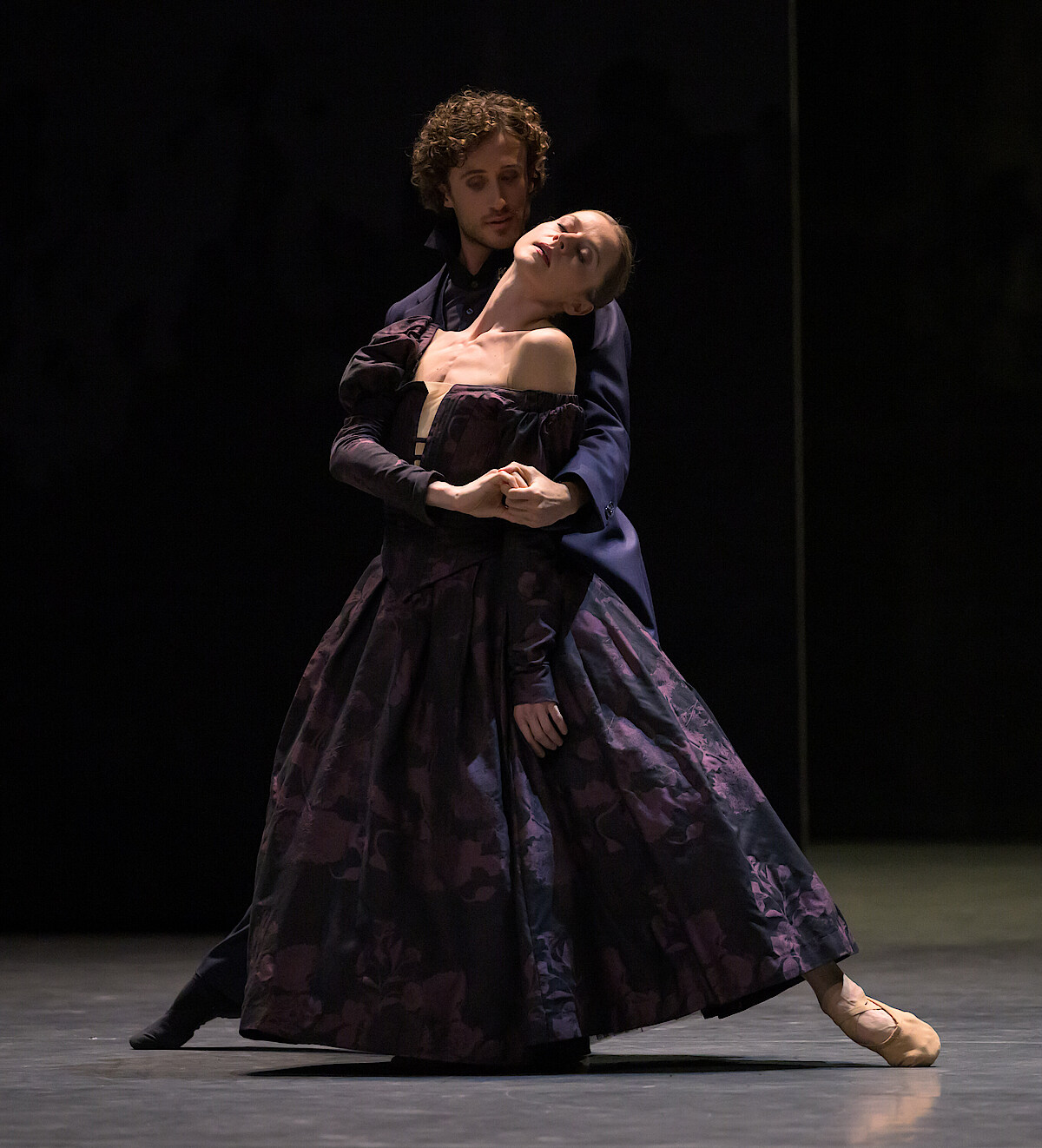
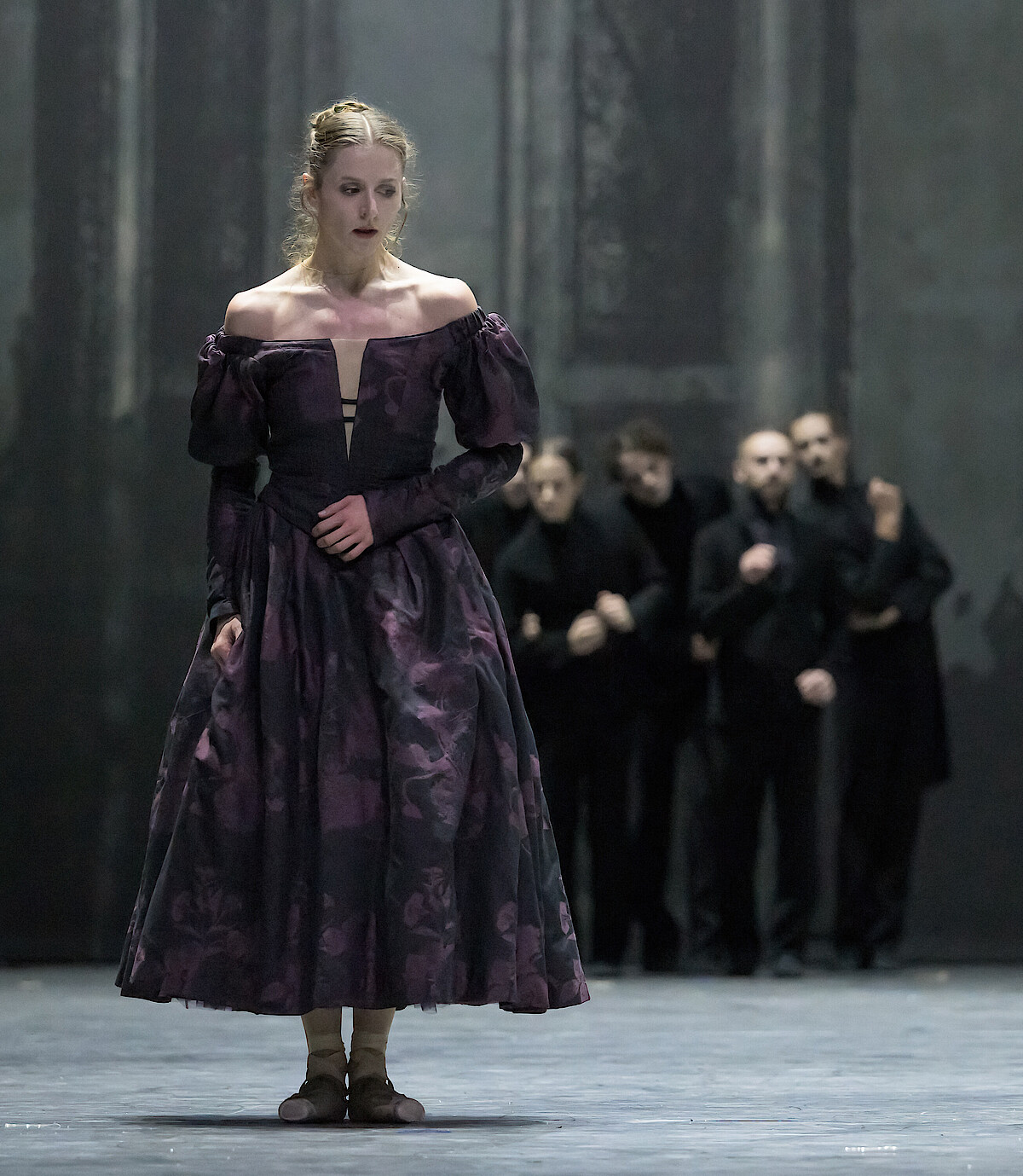
«The text is sparkling like the bubbles in a champagne glass.»
Weronika Frodyma about her role in Bovary.
Staatsballett Berlin (SBB) Who is Emma Bovary for you?
Weronika Frodyma (WF) When I read the book, I was a little surprised by what I read. [Emma Bovary] is very selfish or self-centered, but I could also identify with so many aspects of her personality. I thought, «This is how I feel; this is how I think.» I had to ask myself, «Am I Bovary?» On the other hand, I got annoyed with her: «Girl, this is just your fantasy. This is simply not reality. You can't expect that to work. You can't be so selfish and belittle all these people for your own pleasure.» But at the same time, I sympathize with her. Reading the book was a journey of discovery. You definitely start questioning yourself, your desires, and dreams.
SBB Which character traits has Christian Spuck asked you to emphasize?
WF He didn't really specify. He didn't create a psychological profile of her. It developed more in different situations we rehearsed. He gives situation-specific hints. He presented her as this woman who exists between dreams and reality. That's a very important aspect of her character, that she is so frustrated with her life because it simply doesn't match the fantasy she created for herself.
SBB Is she a contemporary figure for you?
WF Her story is so relevant; it's a very human story. These stories repeat themselves, no matter the time, no matter what conventions prevail. We are humans and have similar desires, needs that we want to fulfil in our lives. That's why this story is timeless, even if societal judgment would be different now. I'm sure it still exists today.
SBB How do the spoken passages from the book influence your dancing?
WF The text is sparkling like the bubbles in a champagne glass. The poetry of the dance contrasts with the words. They highlight the drama of the situation; it gets under your skin. And when I start to dance and hear the music, all senses open up, and then these sentences from the book resonate directly with me. They go deeper than if you were just reading them on paper.
SBB What do you think is the motive behind her suicide?
WF Her suicide is the «easy» way out of her problems; a selfish act that strongly shapes her character throughout her life. A quick way to satisfy her own needs and desires, to end her pain, her fear, the unbearable weight of the pressure on her, and the inevitable confrontation with reality. Without thinking about how it could influence those around her. Just as she always did... Everything is based on lies and money she doesn't have. And on pretending to be someone she is not. It's a way to not have to see herself in the mirror, without the money, the beautiful clothes, the unattainable dreams and passionate lovers. Simply the plain and unspectacular Emma she doesn't want to be.
SBB Something that is not unusual when you look at today's obsession with social media.
WF It's something human in general, not just in social media. I think social media takes it to another level. Even before there were social media, we all somehow thought that we had to create a certain image of ourselves: be strong, reliable, always cheerful, even when suffering. So there are certain masks we put on to get through a day professionally. But then there is of course this absolute extreme in social media. And I think that's closer to what Emma did: all these clothes, all these filters, how to look, what to own, what to do. And none of it is based on reality. It's just a beautiful construction without any foundation.
Quoted from the Ballet Paper No. 1. The conversation was conducted by Michael Hoh.
«The costumes tell a story»
Studio visit with costume designer Emma Ryott
In the production of Bovary, it's not just the dancers who take centre stage: Over 100 handmade and custom-tailored costumes set the scene. They are crafted in the workshops of the Stage Service. Visiting a place where theatre dreams come true.
Bühnenservice Berlin (Stage Service Berlin), seven weeks before the premiere of Bovary: Two ladies stand before a heap of colourful ostrich feathers, rhinestones, and tulle, arranging them in different variations and examining the interplay of materials. Costume designer Emma Ryott is there to oversee the creation of costumes for the production of Bovary. Together with Anita Fremy, a milliner at the Opera Foundation in Berlin, she contemplates the elaborate headpieces needed for the scene called the «Revue». In this scene, the protagonist Emma Bovary, a country doctor's wife, visits the theatre in the nearest town of Rouen with her husband and is swept away by a dazzling world as a contrast to her rural life. The costumes play a significant role in telling this story.
Just under a month before the grand premiere, almost all dresses are either completed or in the process of being made. Over a hundred tailor-made gowns are made just for the first cast. The second cast must also be ready as last-minute cast changes are always possible. The costume team is already in the final stretch of this production.
The costume design process begins right at the beginning of a play's development. «About a year and a half ago, we met for a brainstorming weekend,» says Emma Ryott. «We», meaning choreographer Christian Spuck and his artistic team, including dramaturg Claus Spahn, set designer Rufus Didwiszus, and costume designer Emma Ryott. «This weekend was very focused; we had many conversations, looked at images, reflected on the book. And then we pooled our ideas and saw if we were moving in the right direction together.» The resulting overall concept was carried into the Stage Service workshops over the following months and brought to life there.
At the Bühnenservice Berlin, Germany's largest theatre service provider, all costumes for the Opera Foundation in Berlin are made – for the three operas and the State Ballet Berlin. In the workshop and administration complex at Ostbahnhof, theatre dreams come true. Around 260 employees work on an area of 25,000 square meters, from set construction to costume making to personnel services. Emma Ryott can fully rely on the staff there, six costume masters, and up to four milliners working on the production. «It's a great teamwork, and it's important that we trust each other and can have a dialogue.» The Englishwoman is internationally active as a costume and set designer. Currently, alongside the premiere in Berlin, she juggles three productions in Canada, England, and Dresden. She has been collaborating with Christian Spuck since 2003 and the production of Lulu. A Monster Tragedy. She visits Berlin for several days and weeks for Bovary, attends fittings with the dancers, and exchanges ideas with the team about the progress of costume making.
What are her guiding ideas for the different costumes? «The costumes are loosely set in the 1850s. It's sort of my version of 1850. Historical costumes were more detailed. Here, there's less clutter.» Modern, simple cuts are also seen repeatedly, supporting the breaking of the narrative structure. «The abstract and historical costumes are connected through a shared colour palette.» Additionally, the different life worlds and their garments contrast: In the village of Yonville, earthbound people live in peasant clothing; at the ball, the refined and cultured upper class is evident, and in the theatre scene, a fantastical world is experienced.
Besides the thematic inspiration, practical questions are also significant because: «Everything has to move.» The clothing must provide great freedom of movement for the dancers, while the expansive movements can also create beautiful effects with swaying fabrics. For a skirt, 15 metres of fabric can be used. For a successful performance, no effort is too great for the costume designers. To make the suits of the village population appear old and used, for example, a multi-day process is used. The new jackets are moistened and hung on mannequins. To create folds and bulges, the sleeves are tied with cords, and stones are placed in the pockets. After a few days, the suit is dry and seems to have aged by several years.
On October 19, 2023, one day before the premiere, Emma Ryott and her colleagues from Stage Service will sit in the audience during the general rehearsal of Bovary and check one last time if everything fits as it should and if ostrich feathers, rhinestones, and tulle achieve the desired effect. «The costumes tell a story. It's always about telling a story.»
Quoted from the Ballet Paper No. 1, author: Corinna Erlebach
